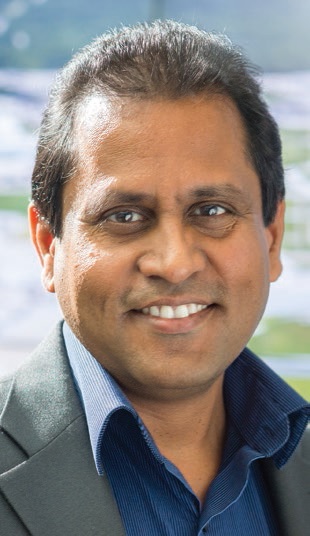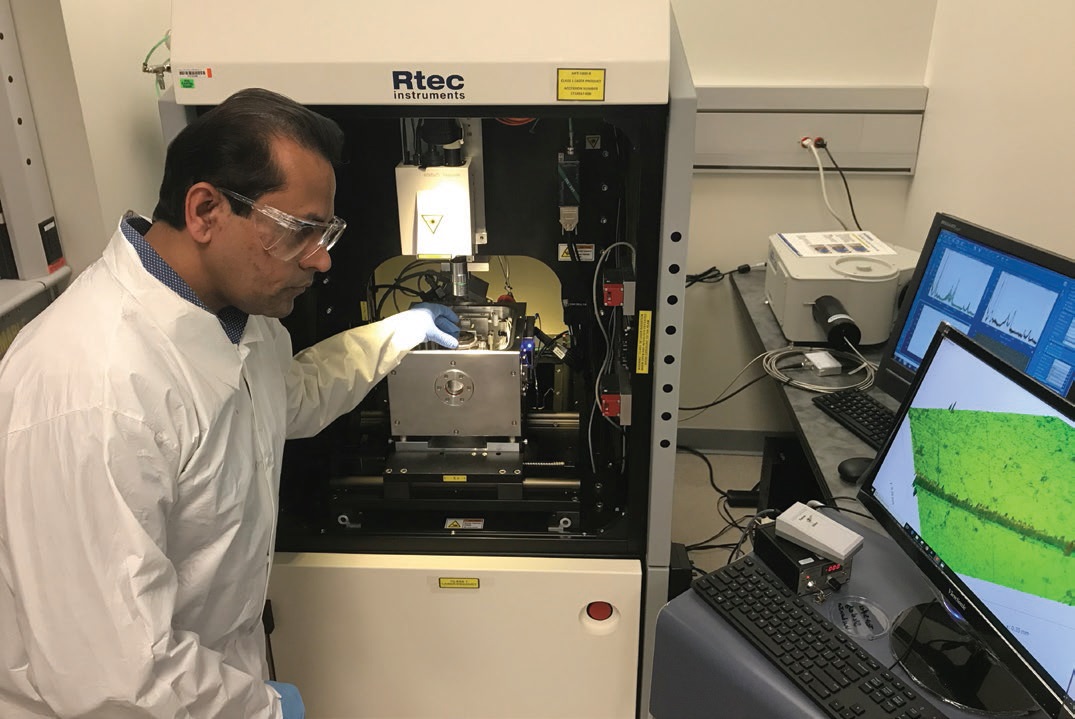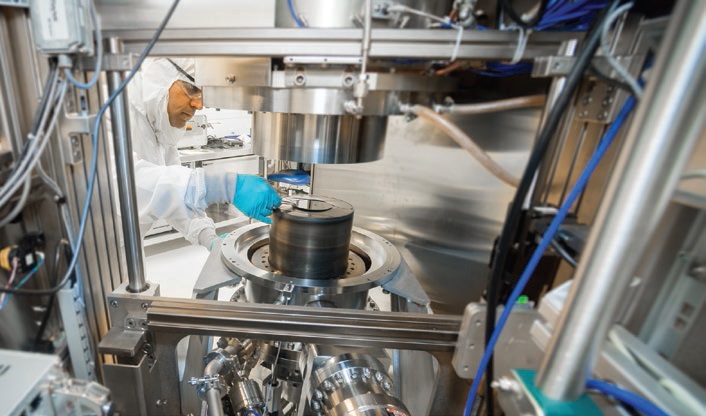20 Minutes With Anirudha V. Sumant
Rachel Fowler, Managing Editor | TLT 20 Minutes April 2018
This materials scientist with Argonne National Laboratory develops energy-efficient systems based on novel carbon materials.
Dr. Anirudha Sumant - The Quick File
Dr. Anirudha Sumant is a materials scientist for the Center for Nanoscale Materials at Argonne National Laboratory. He received his doctorate degree in electronic science from University of Pune, India, in 1998. He was a post-doctoral fellow at Argonne National Laboratory from 1998-2001. After spending a couple of years in the start-up industry, he joined University of Wisconsin-Madison in 2003 and held the staff scientist position until 2006. He then joined the Center for Nanoscale Materials at Argonne National Laboratory in 2006; since then he has lead the research on nanocarbon materials including CVD diamond, carbon nanotube and graphene.
Sumant has more than 22 years of research experience in the synthesis, characterization and developing applications of carbon-based materials. His main research interests include electronic, mechanical and tribological properties of carbon-based materials, surface chemistry, micro/nanoscale tribology and micro-nanofabrication.
Sumant is the author and co-author of more than 120 peer-reviewed journal publications and two book chapters. He is the winner of four R&D 100 awards, the NASA Tech Brief Magazine Award, Pinnacle of Education Award from the Board of Governors by UChicago Argonne, LLC and two TechConnect National Innovation Awards. He has 21 patents granted with 23 pending and has given numerous invited talks. His research in diamond materials helped in the formation of several start-up companies including NCD Technologies and AKHAN Semiconductor, Inc. Recently one of his inventions was licensed by United Scientific Supplies, Inc., in creating a STEM education product called the NextGen STEM Kit specially designed for high school students. He is a member of STLE, the Materials Research Society and Science and Technology of Materials, Interfaces, and Processing (AVS).

Dr. Anirudha Sumant
TLT: Why is Argonne interested in diamond-based coatings?
Sumant: Argonne has a long history of more than two decades of continuing cutting-edge research related to novel carbon materials, particularly on ultrananocrystalline diamond (UNCD). This goes back to 1998 when I was a post-doc working on tribological properties of UNCD coatings for mechanical shaft seal applications. This project was in collaboration with STLE’s Immediate Past President Dr. Ali Erdemir at Argonne, and we helped in developing a new technology in reducing friction and wear in SiC-based mechanical shaft seals. Later this technology was further developed and commercialized by Argonne's spinoff company, Advanced Diamond Technologies (ADT), Inc. The UNCD-coated shaft seals from ADT are in the market from the last 10 years as a product.
Argonne is well known for cutting-edge research on materials, whether it is related to carbon materials or battery materials or discovering new materials through a state-of-the-art advanced photon source. In 2006, with the opening of the Center for Nanoscale Materials at Argonne as one of the nanoscience centers established by the Department of Energy (DOE), the research on carbon materials was recognized as one of the theme areas that I currently lead.
In the last 11 years in my group, we have not only developed several new technologies based on UNCD—which are on the way of commercialization, and some of them are commercialized—but also developed new areas of research in graphene and other 2D materials, which has now become a central part of my research activities. Argonne and DOE have been very supportive of our programs on novel carbon materials because of not only groundbreaking research on the fundamental level but also taking that research to the next level by working with industry and translating that into the product in the U.S. market and helping the U.S. economy.
TLT: What are the goals of your current leading program on nanocrystalline carbon materials?
Sumant: The central theme of my research work at Argonne is on developing energy efficient systems based on novel carbon materials. This includes fundamental studies on understanding electronic properties of hybrid carbon materials and developing microelectromechanical systems/nanoelectromechanical systems (MEMS/NEMS) and electronic devices with superior device performance. It also includes fundamental studies on the tribological properties of carbon materials and developing next generation of oil-free solid lubricants based on graphene and other 2D materials. The aim is to reduce hazardous waste in the environment and significantly improve reducing wear/friction at a lower cost.
TLT: What are the potential applications of this work?
Sumant: For the ultrananocrystalline diamond, we have been working with the industry in developing the next generation of field emission-based electron sources to be used for electron accelerators, hand-held X-ray guns for medical diagnosis or security screening. In the MEMS area, we have developed advanced RF-MEMS switches based on diamond that are ultrafast with less noise and can operate at higher frequency in harsh environmental conditions. For our work on graphene, we have shown that it is the next emerging solid lubricant with fundamentally different wear/friction mechanisms than that of thin film or bulk materials. The current research work on superlubricity is now progressed from fundamental research into two major DOE programs with industry partners with the goal to develop real-world products in the mechanical seal industry as well as in the automotive industry.
 Anirudha Sumant with the new multifunctional tribometer examining wear/friction properties of solid lubricants in the newly established superlubricity laboratory at the Center for Nanoscale Materials at Argonne National Laboratory. (Photo courtesy of Argonne National Laboratory.)
TLT: Which part of this work brings you the most difficulties?
Sumant:
Anirudha Sumant with the new multifunctional tribometer examining wear/friction properties of solid lubricants in the newly established superlubricity laboratory at the Center for Nanoscale Materials at Argonne National Laboratory. (Photo courtesy of Argonne National Laboratory.)
TLT: Which part of this work brings you the most difficulties?
Sumant: I generally enjoy all aspects of my research work and any form of difficulties that come along with it. If I have to pinpoint some part that requires more of my time and efforts, that would be taking discoveries from the lab bench and translating them into real-world products by working with the industry. Being at a national lab, our mission is not only to carry out breakthrough fundamental research work but also taking those discoveries to the next phase by working collaboratively with the industry and helping them to come up with a product.
The best examples are ultrananocrystalline diamond-coated mechanical shaft seals that are in the market by Argonne’s spin-off company ADT and the NextGen STEM Kit, a nanotechnology educational kit based on ultrananocrystalline diamond specially designed for teaching nanotechnology to high school students. This product is developed by United Scientific Supplies, Inc., by working collaboratively with Argonne. EuclidTech Lab has developed a plug-and-play field emission electron source based on UNCD for accelerator applications and will be in the market soon.
TLT: What current projects are you interested in?
Sumant: Apart from various research projects on diamond, my current research activity is focused on further understanding macroscale superlubricity based on graphene and other 2D materials. We have established a research program on superlubricity at the Center for Nanoscale Materials at Argonne. Under this program we have recently acquired a multifunctional tribometer from Rtec Instruments, Inc., which has several unique capabilities such as the ability to carry out wear/friction studies in high-vacuum, high temperatures and in controlled atmospheres with integrated confocal Raman spectroscopy and 3D confocal profilometry. These features will allow us to investigate tribochemical modifications occurring within a wear track as a function of various tribological conditions. This facility will be open to outside users later this year. We have arranged a special symposium on superlubricity in May 2018 during our annual users meeting with various experts coming from different parts of the world and presenting their work on superlubricity. This symposium also will offer a visit to our superlubricity lab and more details on the multifunctional tribometer.
 Anirudha Sumant loading a silicon wafer to synthesize ultrananocrystalline diamond thin film in the microwave plasma chemical vapor deposition (MPCVD) system located in the clean room at the Center for Nanoscale Materials at Argonne National Laboratory. (Photo courtesy of Argonne National Laboratory.)
TLT: Can young tribologists join you in this program?
Sumant:
Anirudha Sumant loading a silicon wafer to synthesize ultrananocrystalline diamond thin film in the microwave plasma chemical vapor deposition (MPCVD) system located in the clean room at the Center for Nanoscale Materials at Argonne National Laboratory. (Photo courtesy of Argonne National Laboratory.)
TLT: Can young tribologists join you in this program?
Sumant: Absolutely. Argonne has several programs that offer young researchers an opportunity to work at various stages. The summer internship program for undergraduates is an excellent program that allows them to work with an Argonne scientist. Graduate students working in related areas can work directly with Argonne scientists by submitting user proposals at the Center for Nanoscale Materials.
At the post-doctoral level, there are competitive post-doctoral fellowships such as the Director’s Fellowship or Named Fellowship, which are very prestigious fellowships. Apart from those, there are several divisional post-doctoral fellowships that are available based on various ongoing projects at Argonne. These post-doctoral positions can be accessed by visiting Argonne’s career page at
www.anl.gov/careers.
You can reach Dr. Anirudha Sumant at sumant@anl.gov.